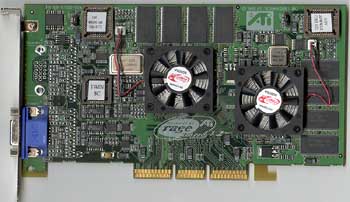The Specs
The specs of the Rage Fury MAXX are quite impressive as the card features a whopping 64MB of on-board SDRAM clocked at 143MHz. The 64MB of SDRAM is split into 32MB per Rage 128 Pro chip on the board. Like a Voodoo2 SLI setup, textures must be duplicated for each chip, but framebuffer memory can be shared between the two memory banks. Nevertheless, this provides for a tremendous amount of available memory bandwidth. Taking the 128-bit (16-byte) memory pipeline and multiplying it by the 143MHz memory bus frequency of the Rage Fury MAXX results in an available memory bandwidth of about 2.3GB/s. But we're not done yet! In order to finish the memory bandwidth calculations, you must double that number because of the two dedicated memory busses, one per chip, present on the Rage Fury MAXX. This increases the available memory bandwidth to an incredible 4.6GB/s, which outweighs the 2.7GB/s of NVIDIA's GeForce 256 and even the 3.2GB/s of the Matrox G400MAX. The only card the Rage Fury MAXX isn't able to beat on paper in terms of available memory bandwidth is a GeForce 256 equipped with DDR SDRAM, which has approximately 5.3GB/s of available memory bandwidth.
Why does offering a greater amount of memory bandwidth matter? As you increase the resolution and color depth that you're playing your game at, you begin to require much more memory per frame of data that you are displaying. The greater the memory bandwidth your graphics subsystem or video card allows for, the less noticeable of a performance hit you'll be forced to take as you increase the resolution and color depth that you are playing at. So, while the performance advantage of the Rage Fury MAXX's 4.6GB/s peak memory bandwidth over the GeForce SDR's 2.7GB/s won't be seen running at 640x480 at 16-bit color, the MAXX will begin to pull away from its NVIDIA-born counterpart at resolutions of 1024x768 at 32-bit and at higher resolutions.
As we mentioned before, the dual Rage 128 Pro chips not only double the available memory bandwidth but also the peak fill rate of the card. This transforms the unsurprising 250 Mpixel/s fill rate of a single Rage 128 Pro into a monstrous 500 Mpixel/s fill rate of the Rage Fury MAXX. The fill rate of the Rage Fury MAXX can be considered its raw horse power to all you car-fanatics out there (don't worry, the first requirement to work at AnandTech is that you must be a car-guy or gal) and it is what helps to drive the high frame rates in Quake 3 or UnrealTournament. Currently, the Rage Fury MAXX remains unmatched in terms of raw fill rate of a released product; the only other products we are aware of that will be able to beat out the Rage Fury MAXX won't be seen until sometime into the first half of next year.
In addition to offering good performance on paper (we'll get to the actual benchmarks in a bit to see if they follow up their claims), ATI brings to the table their usual set of DVD enhancements and features that help to separate them from the crowd. The hardware assisted DVD playback of the Rage Fury MAXX is obviously identical to that of the Rage Fury Pro since they are both based on the same chip.











0 Comments
View All Comments